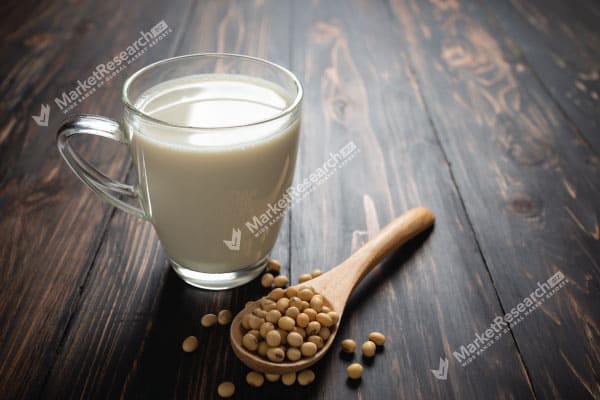
Global Soy Milk Market Forecast, Trend Analysis And Competition Tracking - Global Market insights 2015 to 2031
-
30010
-
May 2023
-
178
-
-
This report was compiled by Correspondence Linkedin | Detailed Market research Methodology Our methodology involves a mix of primary research, including interviews with leading mental health experts, and secondary research from reputable medical journals and databases. View Detailed Methodology Page
-
Soy Milk Market Overview:
“The Soy Milk Market size is expected to be worth around US$ xx Billion by 2021 from US$ X.xx million in 2031, growing at a CAGR of X.x% during the forecast period 2021 to 2031.
Soy milk is alternative to dairy milk to avoid lactose and animal products. Soy milk contains up to five times as much protein as regular cow's milk and is rich in essential amino acids and calcium.
It has significantly less sugar than most non-dairy alternatives, which helps reduce one's risk of diabetes and heart disease.
Soy milk is a dairy substitute that normally comes in many different flavors. It is made from soybeans water, and other vitamins and minerals.
Soy milk contains no lactose. The creaminess of soy milk can vary depending on whether or not it has been heat-treated.
Soy milk contains a higher ratio of proteins, vitamins, and minerals than other dairy products. Soy Milk has a lower amount of cholesterol and saturated fats.
It is also lactose-free and vegan, making it a good alternative for people who can't drink regular milk or have allergies to dairy.
Soy milk is a popular drink made from soybeans. It has been used as an alternative to cow's milk in recent years because of its comparable protein profile, low-fat content, and lack of lactose.
It is easily available in grocery stores and is a common addition to cereal, smoothies, coffee drinks, and more. Soy milk offers a creamy texture that is similar to dairy milk and has a lower glycemic index than dairy milk.
How is the demand for soy milk increasing?
Soy milk is one of the fastest-growing segments in the dairy industry. Recent research has shown that non-dairy milk options are much more popular among younger consumers, which could be an indication that it might overtake cow's milk as the leading choice in coming years. Increasing awareness about health among people about the high levels of sugar in cow's milk also make soy milk a more attractive option for many consumers.
Factors limiting the revenue growth of the soy milk market
Soy milk is an “alternative to animal-based products” that is often touted as a healthier alternative to dairy milk. There are several disadvantages of soymilk, the most significant being its lack of Vitamin D. Soymilk is not fortified with vitamin D like cow milk, which makes it difficult for soymilk drinkers to meet their vitamin D requirements without taking supplements.
Key opportunities for the revenue growth in the soy milk market
Potential opportunities for Soy Milk manufacturing companies include marketing the product as a diet supplement, expanding the product to include more than just soy beans, and creating more flavors such as chocolate. The marketing of Soy Milk as a diet supplement is one of the most lucrative options. Soy Beans are protein-rich and low in saturated fat, making them an ideal choice for those looking to options to lose weight or maintain their weight.
COVID-19 Impact Analysis
COVID-19 is an unparalleled global public health emergency that has impacted virtually every industry, so while demand remains high, soymilk sales have declined due to unprecedented pressure on supply chains due to enforced lockdowns around the world. However, the outbreak has increased the penetration of online portals such as Amazon and Walmart. As a result, more and more soymilk manufacturers are trying to expand their product offerings through online portals, while adopting omni-channel distribution to expand their consumer base.
Soy Milk Market Regional Analysis
The Asia-Pacific region in the global soy milk market is expected to account for significant market share among others
The Asia-Pacific is leading the soy milk market because of its soy consumption and its large population. Asia-pacific has a population of 4 billion and soy consumption is most prevalent in China and Japan.
Soy consumption in Asia-Pacific is at 22.5 million metric tons per year and is expected to increase by 50% over the next few years.
North America is expected to be the fastest-growing market owing to the increasing consumption of non-dairy alternatives. However, the product faces competition from almond milk in the region as consumers find nuts and nut-based beverages healthy.
However, with numerous studies proving the benefits of soy milk, consumers prefer this product over other alternatives such as almond, rice, and coconut milk.
Soy Milk Market Competitive Landscape
A list of the major leading players operating in the Global Soy Milk Market is mentioned below:
-
Pureharvest
-
Alpro (Danone, WhiteWave Foods)
-
Eden Foods Inc.
-
Campbell Soup Company
-
The Hershey Company
-
Vitasoy International Holdings Ltd.
-
Kikkoman Pearl Soy Milk
-
The Hain Celestial Group, Inc
-
Pacific Foods of Oregon LLC.
-
Soy Fresh
-
Other Key Industry Players
Top 3 Overall Soy Milk Brands
Silk Vanilla Soymilk, Signature Organic Soymilk, and Yeo’s Soymilk
Report Scope
-
Forecast Period: 2022-2031
-
Actual Year: 2021
-
Historical Data Available for: 2015-2020
Key Segments Covered
Global Soy Milk Market, By Product Type
-
Flavored Soy Milk
-
Unflavored Soy Milk
Global Soy Milk Market, By Category
-
Organic
-
Conventional
Global Soy Milk Market, By Distribution Channel
-
Desserts
-
Cheese and Snacks
-
Other Applications
Global Soy Milk Market, By Distribution Channel
-
Hypermarket/Supermarket
-
Convenience Stores
-
Online Stores
-
Other Distribution Channels
Attribute Report Details Market Size Ask For Market Size Growth Rate Ask For Growth Rate Key Companies Ask For Companies Report Coverage Revenue analysis, Competitive landscape, Key company analysis, Market Trends, Key segments, Distribution Channel, Market Dynamics, COVID-19 Impact Analysis and more… Historical Data Period 2015-2020 Base Year 2022 Forecast Period 2022-2031 Region Scope North America, Europe, Asia-Pacific, South America, Middle East & Africa Country Scope United States, Canada and Mexico, Germany, France, UK, Russia and Italy, China, Japan, Korea, India and Southeast Asia, Brazil, Argentina, Colombia etc.Saudi Arabia, UAE, Egypt, Nigeria and South Africa Revenue in US$ Mn -
-
-
-
Alpro (Danone, WhiteWave Foods)
-
Eden Foods Inc.
-
Campbell Soup Company
-
The Hershey Company
-
Vitasoy International Holdings Ltd.
-
Kikkoman Pearl Soy Milk
-
The Hain Celestial Group, Inc
-
Pacific Foods of Oregon LLC.
-
Soy Fresh
-
Other Key Industry Players
Frequently Asked Questions (FAQ)
The vitamins, minerals and antioxidants in soy milk can provide important health benefits. Soy milk is rich in omega-3 fatty acids, which are "healthy" fats that the body cannot make on its own. Soy milk can also help support the cardiovascular system. Soy milk is an excellent source of potassium.
One cup of unsweetened soy milk has about 80 to 100 calories. 4g carbs (sweetened varieties have more) 4g fat.




